Petzyo Top Breed Guide
Cane Corso
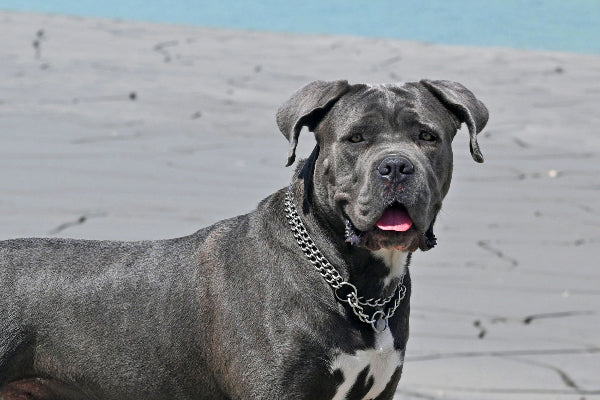
QUICK FACTS
Height: 60–70 cm (males), 58–66 cm (females)
Weight: 45–50 kg (males), 40–45 kg (females)
Lifespan: 9–12 years
Breed Group: Working Dog
Shed Level: Low - Moderate
Energy Level: Moderate – High
Temperament:
Loyal, protective, confident
Common Health Concerns:
Hip dysplasia, bloat, eye conditions (entropion)
Grooming Needs:
Low–weekly brushing and basic upkeep
- Breed Overview
- Physical & Appearance
- Personality
- Health & Diet
- Grooming & Care
- Cost & Owership
The Origins of Cane Corso
The Cane Corso comes from the Molossus line of working dogs from Ancient Greece. Roman soldiers brought these dogs back from the Greek Islands and crossed them with Neapolitan Mastiffs, creating the early Cane Corso.
Originally used as war dogs, they were later relied on for boar hunting, herding, and guarding farms across Italy. By the mid-1900s, the breed declined due to war, farming changes, and economic hardship.
In the 1970s, Italian breeders revived the Cane Corso, and the Society Amorati Cane Corso was formed in 1983. The breed gained recognition across Europe and was formally recognised by the Australian National Kennel Council in 2003. Today, they’re used in guard work, police roles, and as protective family dogs.

Breed summary
Cane Corso is a large and powerful working breed known for its loyalty, intelligence, and protective nature. Originally bred as guard dogs and hunters, Cane Corsos are confident, trainable, and thrive with experienced owners who can provide firm and consistent leadership.
Cane Corsos have short, dense coats that are low-maintenance. Their grooming needs consist of occasional brushing and regular checks of their ears, nails, and teeth. This breed is best suited for homes with ample space to move around, a clear routine, and owners who are dedicated to providing both mental and physical stimulation.
While Cane Corsos are naturally affectionate with their families, they can be wary of strangers, making early socialisation essential.
In terms of health, Cane Corsos are generally robust, but they may be prone to certain conditions, such as hip and elbow dysplasia, heart issues, and bloat. A high-protein, balanced diet tailored to large breeds is crucial for maintaining their muscle mass and joint health.
FAQs About Can Corso
Is a Cane Corso a Good Family Dog?
Yes, Cane Corsos can be great family dogs when raised with early socialisation, structure, and consistent training. They’re loyal, protective, and form strong bonds with their people. However, due to their size and strength, they’re best suited for families with dog experience and older children. Supervision is essential around younger kids to prevent accidental knock-overs during play.
Are Cane Corso Banned in Australia?
No, Cane Corsos are not banned in Australia. They are recognised by the Australian National Kennel Council (ANKC) and are legal to own in all states and territories. However, local councils may have specific regulations around registration, fencing, and secure containment—especially for large guardian breeds. Always check with your local council before bringing one home.
What is the Bite Force of a Cane Corso?
The bite force of a Cane Corso is estimated at around 650–700 PSI (pounds per square inch). That’s stronger than most dog breeds and is similar to wild predators like wolves.
Coat type
Coat length
Appearance & Physical Characteristics
The Cane Corso makes a strong first impression—and for good reason. From head to tail, every part of the Corso is designed to move with purpose and stand with confidence.
Size, Build, and Coat Type
The Cane Corso is a large and athletic breed with a deep chest, thick neck, and sturdy legs built for endurance. Males typically stand between 60–70 cm and weigh 45–50 kg, while females range from 58–66 cm and 40–45 kg.
Some standout physical features include:
- Head: Large, square, with a broad forehead and defined jaw
- Eyes: Dark, almond-shaped, and always alert—expressing the breed’s intelligence
- Ears: Usually left natural and floppy, though cropped ears still appear in some regions
- Tail: Commonly docked, but natural long tails are just as accepted
Their short, dense double coat sits close to the skin and has a slightly coarse texture. While Cane Corsos shed lightly throughout the year, you’ll notice a bit more during seasonal changes, especially in spring.
Common Colour Variations and Markings
Eye colour is typically dark brown, though lighter shades can show up in grey-coated dogs. Their coat colour can sometimes influence how much dirt or shedding is visible between brushes—but it doesn’t change how low-maintenance they really are.
Corsi comes in a variety of solid and brindle coat colours, all recognised within breed standards. Some of the most common shades include:
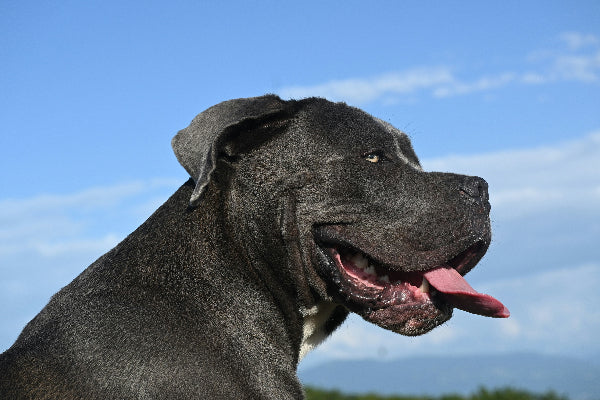
Black
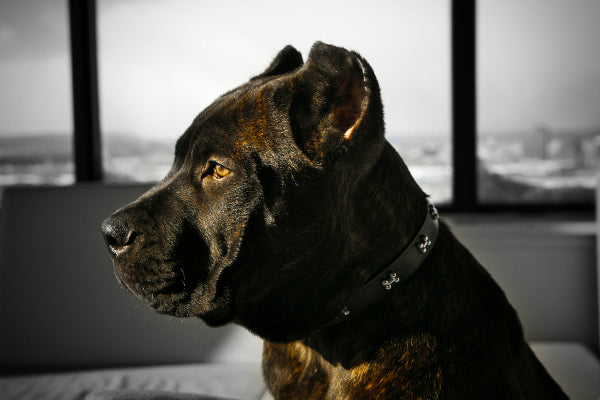
Brindle
Grey or black base with lighter striping
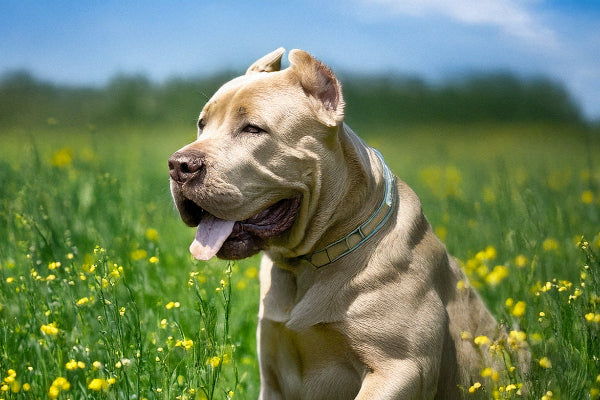
Fawn

Grey
Various shades of grey
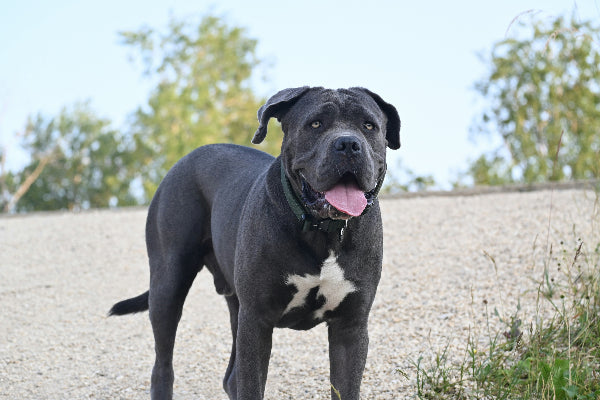
Mixed colours
Sometimes with white patches on the chest, chin, or toes
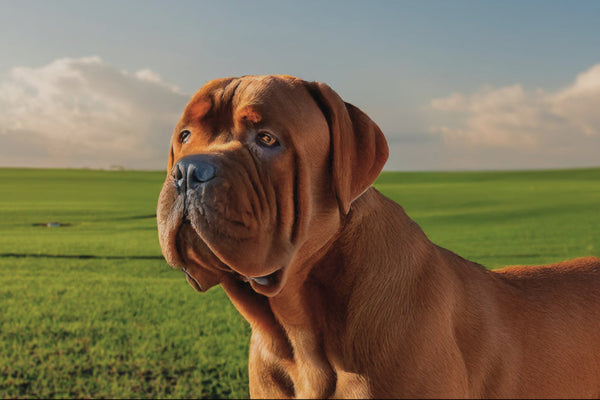
Stag Red
Affectionate with family
Good with kids
Social doggos
Playfulness
Cane Corso Temperament & Personality
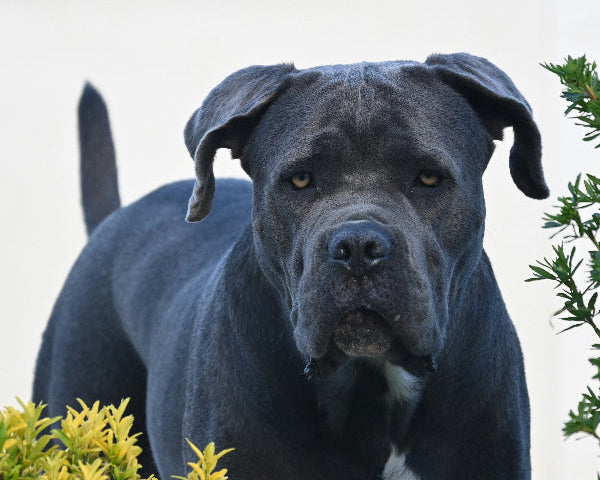
The Cane Corso is a serious dog with a steady mind. These dogs aren’t for everyone—but for the right owner, they’re an incredibly rewarding companion.
Core Traits: Loyal, Protective, and Intelligent
Cane Corsos are known for their bold personalities and working instincts. Here’s what to expect from their core traits:
- Highly intelligent: They pick up on patterns quickly and respond well to consistent, positive training.
- Loyal and brave: They’re deeply committed to their people and won’t hesitate to step up when they feel something’s off.
- Confident and assertive: They carry themselves with calm control but need to know someone else is calling the shots.
- Natural leaders: Without clear rules early on, they may take over the role of “head of the house.”
- Independent, not aloof: They’re not needy—but they do like being close enough to keep tabs on everything.
Interaction with Children and Other Pets
Cane Corsos can do well in family homes—but only if they’re raised with the right boundaries and exposure.
- With kids: They’re often gentle and protective, but their sheer size means play must always be supervised—especially around toddlers. Teach children to respect their space and avoid rough play.
- With other dogs: Early introductions and controlled environments are key. Corsi are often best with opposite-sex dogs and may not tolerate same-sex dominance.
- With other pets: If raised with them, Corsos can live peacefully alongside cats and small animals—but it’s case by case. Slow, structured introductions are a must.
Cane Corso Lifespan & Health Issues
Cane Corsos typically live between 9 to 12 years. Their lifespan can be influenced by factors such as genetics, diet, exercise, and healthcare. Responsible breeding helps reduce the risk of inherited conditions like hip and elbow dysplasia, heart disease, and entropion. Maintaining a healthy weight, consuming a balanced diet, and engaging in regular exercise are essential for promoting joint and heart health. Routine veterinary check-ups and preventative care can further enhance their quality of life. With attentive care, some Cane Corsos may live beyond 12 years.
Common Health Issues in Cane Corsos
While generally healthy, Cane Corsos are prone to a few conditions—many of which can be managed or prevented with early care.
1. Hip & Elbow Dysplasia
Joint conditions that cause pain and stiffness over time. Symptoms include limping, stiffness, or reluctance to move. Weight control, joint supplements, anti-inflammatories, and in serious cases, surgery.
2. Bloat (GDV)
A life-threatening condition where the stomach twists. Symptoms include a swollen belly, non-productive vomiting, and signs of pain. Avoid heavy meals before/after exercise. Ask your vet about a gastropexy, often done during spay/neuter to reduce risk.
3. Idiopathic Epilepsy
Seizures usually begin around 1–5 years of age. No known cure, but medication can manage it well. Dogs can live full lives with treatment.
4. Obesity
A serious risk in large breeds. Excess weight can worsen joint issues and lower their quality of life.
5. Eyelid Issues
Includes entropion, ectropion, and cherry eye.
- Symptoms: Eye irritation, excessive tearing, or a visible red mass in the corner of the eye.
- Treatment: Surgical correction plus topical care post-op.
Routine Vet Check-ups and Preventative Care
- Regular vet care and smart lifestyle choices make a big difference in catching these issues early.
- Annual vet visits (or twice yearly for seniors) are essential for catching early signs of illness.
- Stay up to date on core vaccines, flea and tick prevention, and intestinal worming.
- Ask your vet about joint supplements (like green lipped mussels and fish oil), especially for older Corsos.
- Weigh your dog monthly—even a few extra kilos can put unnecessary strain on their joints.
Cane Corso’s Nutrition & Diet Guide
These dog breeds were never bred to sit still—they’re working dogs at heart. From feeding to exercise and weight management, these dogs do best with routine, purpose, and plenty of structure in their day.
Best Diet and Feeding Guidelines
Feeding the right portion is essential to preventing issues like bloat and supporting slow, steady growth in puppies.
Puppy Feeding Tips:
- Feed 3–4 meals per day between 2–6 months of age.
- Choose a high-quality dog food that supports joint development.
- Stick to a set feeding schedule—don’t leave food out all day.
- Use measuring cups to avoid overfeeding.
- Always provide access to fresh, clean water.
As your pup grows, gradually reduce feeding to 2–3 meals a day by the time they reach one year. Want more help with nutrition? Talk to your vet about a personalised feeding plan.
Confused about the feeding schedule? Find out how often you should feed your pup here!
Weight Management
Obesity is a serious concern for large breeds like the Cane Corso. It puts pressure on their joints and increases the risk of health issues like hip dysplasia and heart problems.
- Portion control is essential—use a scale or measuring cup.
- Skip the scraps and limit treats to training rewards only.
- Weigh your dog monthly to track any changes early.
- Choose nutrient-dense food over fillers.
Exercise Requirements to Keep Them Fit and Healthy
Historically Cane Corsos are used for herding livestock, hunting wild game, and even helping with farm duties, they still carry those working instincts today.
- Aim for 45–60 minutes of structured exercise every day.
- Include leash walks, free running (in a safe, fenced area), and games like fetch or tug.
- Keep their mind busy too—obedience training, trick work, and puzzle toys do wonders.
- Some Corsos do well with jobs: therapy work, obedience trials, or even light herding tasks if given the chance. Without enough activity, they can get restless or develop destructive behaviours. They don’t want to be couch potatoes—they want a job.
Struggling with your dog’s weight? Don’t miss our blog to get practical, vet-backed advice on how to help a dog lose weight.
Shedding Amount
Drooling
Coat Grooming Needs
Trainability
Mental Stimulation Needs
Cane Corso Grooming & Maintenance
Like many large breeds, they’re prone to a few genetic conditions, so regular care, early prevention, and smart hygiene habits go a long way in keeping them happy and healthy.
Grooming Needs
The Cane Corso has a short, dense double coat that sheds lightly year-round but goes through heavier shedding (or coat blow-outs) in spring and autumn.
- Shedding: Moderate overall, but seasonal changes can bring sudden increases.
- Brushing: Once a week is enough most of the year, but during shedding periods, aim for daily brushing. Use a rubber grooming mitt, hound glove, or medium-bristle brush to remove loose hair and spread natural oils.
- Coat check: While brushing, check for skin issues like redness, bumps, or dry patches.
Bathing Frequency and General Hygiene Tips
Cane Corsos only need a bath every 6–8 weeks, or when they’re dirty. Over-bathing can dry out their skin and coat.
- Puppy training tip: Start bath time early so they learn it’s nothing to fear. Use lukewarm water and a gentle, dog-safe shampoo.
- Nails: Trim monthly or when you hear clicking on the floor. Their nails are thick, so use proper dog nail clippers—and avoid cutting the quick.
- Ears: Check weekly for redness, smell, or discharge. Wipe the outer ear with a damp cotton ball and dog-safe ear cleaner—never insert anything into the ear canal.
- Teeth: Brush 2–3 times a week using dog toothpaste. Add dental chews for extra help with breath and tartar.
- Eyes: Keep an eye on discharge or redness. Their eyes should be clear and free of irritation.
Training Your Cane Corso
Cane Corsos training isn’t optional, it’s essential. With the right approach, they become calm, well-mannered companions. But without early structure and clear rules, they can quickly become a handful.
Obedience Training and Socialisation Essentials
Start early. Cane Corsos are quick learners, but they need clear direction from the start.
- Basic obedience—like sit, stay, and recall—should begin from 8–10 weeks of age.
- Leash training is vital for a breed this strong. Keep sessions short and consistent.
- Socialisation with people, dogs, sounds, and new places helps prevent overprotectiveness later in life.
- Positive reinforcement (treats, toys, praise) works better than harsh corrections.
Socialising a Cane Corso
With the right start, Corsi can grow into calm, confident companions who know when to switch off the guard dog instinct.
Socialisation Techniques to Prevent Aggression
A well-socialised Cane Corso is calm, confident, and able to assess situations without overreacting. Here’s how to build those traits:
- Start early: Socialisation should begin between 8–16 weeks—the prime learning window.
- Expose them to variety: Introduce new people, places, sounds, and surfaces slowly but regularly.
- Reward calm behaviour: Use treats, praise, or toys to reinforce positive reactions to new experiences.
- Use controlled settings: Avoid busy dog parks at first. Choose quiet, neutral environments where they can observe without overwhelm.
- Ongoing exposure: Socialisation isn’t a one-time thing—it needs to continue through adolescence and adulthood.
Training Tips for First-Time Cane Corso Owners
If you’re new to the breed—or large dogs in general—training can feel intimidating. But with the right mindset, it’s manageable.
- Stay calm and confident. Corsos respect clear, fair leadership.
- Set boundaries early. Don’t allow behaviours when they’re small that you won’t want at 50 kg.
- Use structure: Stick to routines around feeding, walking, and training.
- Keep training sessions short: 5–10 minutes a few times a day is more effective than long drills.
- Consider a professional trainer familiar with guardian breeds to help you build a solid foundation.
Got a Cane Corso who loves to roam? Find the best walking locations in each Australian State—a great way to burn off energy while exploring new places together.

Managing Strong-Willed or Protective Behaviour
Corsi are bred to think independently, which means they may challenge you at times—or react strongly to strangers.
- Don’t avoid triggers: Controlled exposure to people, pets, and places helps them build confidence.
- Teach impulse control: Commands like “leave it” or “place” help them manage their instincts.
- Watch body language: Early signs of tension (staring, stiff posture) give you time to redirect calmly.
- Avoid harsh punishment: It can create fear or aggression—go for redirection, not domination.
Cost & Ownership Considerations
How Much Does a Cane Corse Cost?
In Australia, a Cane Corso puppy from a registered breeder typically costs between $3,000 and $6,000. Price depends on lineage, health screening, breeder reputation, and whether the dog is intended for pet, working, or show purposes. In addition to the initial cost, expect to spend $2,000–$3,000 per year on food, healthcare, grooming, and supplies.
Apartment Living vs. Large Spaces
These dogs are deeply bonded to their people, and they like to stay close—no matter the space or setting. But to keep things smooth at home (and beyond), it helps to understand how they adapt to different environments and situations.
While Cane Corsos are calm indoors, they’re not ideal for small apartments—unless you’re fully committed to daily physical and mental stimulation.
- Apartments: Possible, but not preferred. You’ll need a consistent exercise routine (think 2 long walks daily + mental work).
- Townhouses or units with courtyards: Better—but still need daily activity and supervision.
- Homes with backyards: Ideal. They love space to stretch and watch over. A secure, high fence is a must—they’re territorial and may patrol the boundary.
Climate Adaptability
Cane Corsos are tough, but they’re still sensitive to extreme temps.
- In heat: Their short, dark coats can absorb heat quickly. Walk early or late in summer, provide plenty of shade and cool water, and avoid strenuous activity during hot days.
- In cold: Most Corsos tolerate winter well, but extra insulation may be needed during frosty mornings or long outdoor time. Short walks in cold weather are fine—just keep an eye on their paws and ears.
Consider a light dog coat or vest for chilly days, especially for older dogs or those with low body fat.
